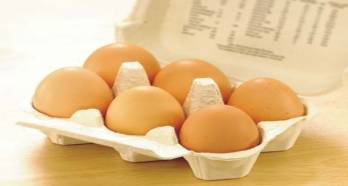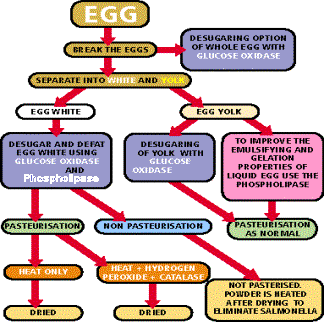
Eggs and processed egg products have been consumed by mankind for centuries. They have nutritive, flavour and functional attributes. Their functional properties make them extremely useful as ingredients in many food processes. Much of the egg consumption is in products such as mayonnaise, salad dressing, pasta, and bakery products. Egg products are active in foaming (meringues and angel cakes) gelation (souffles and quiches) and emulsification (mayonnaise and batters). The major components of egg are the proteins and lipids and these are mainly responsible for the functional attributes. Other components are present in relatively small amounts.
Traditionally egg ingredients were supplied in the form of whole eggs. However today’s food processors can choose from a wide range of egg ingredients where various processes are used to produce liquid, frozen, dried whole eggs, whites or yolks. It used to be that fresh shell eggs and liquid products had the best functionality. However dried egg products have the advantage that they can be easily pasteurised, have excellent shelf life and stability, are easier to ship due to reduced volume and products can be tailored with specific functionality.
A range of enzyme that the egg processor can use to improve the quality of their egg products. Below is a table summarising the common problems occurring during the processing of eggs and how they can be solved.
|
Problem |
Enzyme Solution |
|
Egg white goes brown during pasteurisation and drying |
Desugar with Glucose Oxidase to prevent this |
|
Egg white does not foam |
Eliminate egg yolk lipids with Lipase |
|
Pasteurisation destroys egg functional properties |
Sterilise with hydrogen peroxide and eliminate residual hydrogen peroxide with Catalase |
|
Insufficient emulsion of egg yolk |
Addition of phospholipase will increase emulsification of yolk |
|
Usage Recommendations |
Removal of Hydrogen Peroxide and Desugarisation
If hydrogen
peroxide has been utilised to assist pasteurisation of egg ingredients
Catalase can be utilised to remove residual peroxide. Egg ingredients can be
first partially sterilised using hydrogen peroxide.The hydrogen peroxide for
one tonne of liquid egg product is added slowly with mixing and minutes.A
dose of Catalase into one tonne of liquid can then be added and mixed to
eliminate residual hydrogen peroxide.
Egg white
browning occurs during the pasteurisation and drying processes. Glucose
Oxidase will prevent this by eliminating residual sugars. And a dose of
Glucose Oxidase can be added and mixed.
Generally the above two processes can be carried out at low temperatures eg 7-13oC thus avoiding any possible heat damage. For egg whites addition of peroxide must be more gentle to avoid local disturbances resulting in foaming. It is therefore prudent to reduce the volume of addition and prolong the contact time eg 3 ml per minute of 35% hydrogen peroxide over 10 - 16 hours. For egg white products the pH of the liquid egg whites might require adjustment to 6.8 - 7.0 by slow addition of 5-10% citric acid solution, avoiding denaturation, before the whites are further treated by the above process.
Delipidation
For delipidation of egg ingredients Lipase which may be suitable;the enzyme may be added to the liquid egg, whole egg or yolk.The reaction can be allowed to proceed with mixing at constant time and hours. Once enzyme reaction is complete the material can be processed to remove the lipids.
Improving Emulsifying & Gelation Properties
To improve the emulsifying and gelation properties of liquid egg ingredient phospholipase:The whole egg or a aqueous solution of egg yolk can be prepared.It might be dosed at per litre of egg product. The pH should be checked and adjusted.The reaction should be allowed to proceed with mixing at constant time and hours. The product can then be used for preparative purposes.

FLOW DIAGRAM FOR EGG PROCESSING
